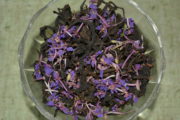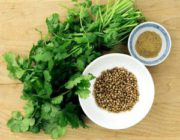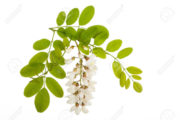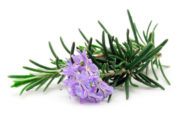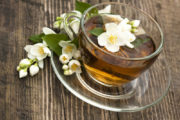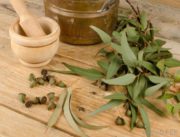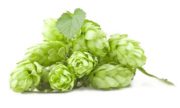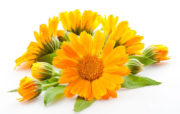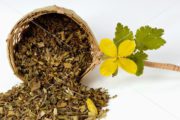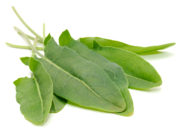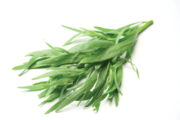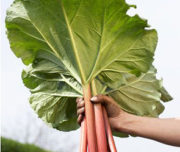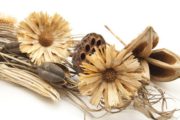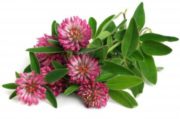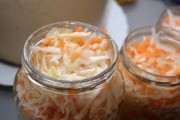Dried herbs, leaves and flowers
The best recipes with photos
Fermented Koporye tea from Ivan tea leaves
Fermented tea made from the fireweed plant or, simply, Ivan tea, has amazing healing and restorative properties. But in order for Koporye tea to “sparkle” with all its colors in your cup, the leaves of Ivan tea must go through not only a long process of collection and drying.
The last notes
Dried cilantro (coriander) for the winter: how and when to dry herbs and cilantro seeds at home
Cilantro is the most popular spice for meat and vegetable dishes. Cilantro is also highly valued in the Caucasus, adding it to almost all dishes. Moreover, not only the green part of the plant is used in cooking, but also the seeds. Many people know cilantro by another name - coriander, but these are just the seeds of cilantro, which are used in baking.
White acacia: harvesting flowers, leaves and bark at home
White acacia flowers have an incredible honey aroma, and acacia is called a “female plant” for its beneficial properties. After all, many “women’s diseases” recede to flavonoids, glycosides, pectins and essential oils of white acacia.
Dried rosemary: ways to prepare spicy herbs - how to dry rosemary at home
Rosemary is a shrub whose young green twigs, flowers and leaves are widely used for culinary and medicinal purposes. The taste and aroma of this plant is spicy, reminiscent of the aroma of coniferous trees.
How to harvest and dry jasmine at home
Jasmine tea is extremely popular in China. Its subtle aroma won the hearts of everyone who tried it at least once. There are many recipes for making jasmine tea, but all of these recipes always use dried jasmine flowers. The matter is complicated by the fact that all teas are sold ready-made, and it is simply impossible to find dried jasmine flowers separately.
Eucalyptus - proper harvesting and drying
Eucalyptus belongs to the myrtle family, and has many varieties, from giant tropical trees, to garden shrubs and decorative indoor varieties. But they all have one thing in common - it is an evergreen plant, and the content of essential oils does not depend on the size of the tree itself. It is the same everywhere and is directly proportional to the size of the sheet.
Hops: rules for collecting and drying at home - preparing hop cones for the winter
Hops are primarily associated with brewing.The tart aromatic taste of the drink is given by the cones formed after the female plant has flowered. Hops are also widely used for medicinal and cosmetic purposes. The chemical elements that make up this plant have anti-inflammatory, antihistamine, analgesic and calming effects. Hop decoctions are used to rinse hair, and are also added to cosmetics to combat acne and dermatitis. To take advantage of the gifts of nature in winter, hop cones need to be collected in a timely manner and properly dried.
How to properly collect and dry calendula for the winter - harvesting calendula at home
Unpretentious calendula often decorates summer cottages. However, many people plant this annual plant of the Asteraceae family not only for decorative purposes, but also to be able to prepare medicinal raw materials for the winter. Harvesting calendula is not a difficult task, but it requires compliance with some rules that will help preserve all the healing properties of this herb.
Celandine - drying at home
Celandine is called a medicinal herb for 100 diseases and its healing properties are compared to ginseng. But, like any medicine, celandine can become a poison if it is not properly prepared and used. We won’t talk about treatment methods, but I will tell you about the correct preparation of celandine.
Dried herbs and fennel seeds - drying at home
Fennel belongs to the umbelliferous family, and in appearance has a great resemblance to dill.But this is only at first glance. Fennel grows up to two meters in height, has a very branched aerial part, and a bulbous root. Fennel also has a different aroma from dill. Instead of the expected dill smell, you will notice a strong, sweet anise aroma.
How to properly dry sorrel at home - preparing sorrel for the winter
Sorrel is a storehouse of vitamins and nutrients. In order to have the opportunity to vitaminize our body in the winter, in the summer we need to take care of the preparation of this herb. There are many ways to do this, but today we will talk in more detail about drying sorrel. Dried herbs, properly prepared at home, retain color, taste and all the beneficial substances.
Harvesting horsetail: rules for collecting and drying - how to dry horsetail at home
Horsetail is a perennial herb that has long been used for medicinal and culinary purposes. The Latin name of this plant, Equiseti herba, translates as “horse tail.” Indeed, the appearance of horsetail resembles a horse's tail. The medicinal raw materials of this herb can be purchased at any pharmacy, but if you want to prepare medicinal raw materials yourself, then this article will give you a lot of useful information about the rules for collecting and drying this plant at home.
Dried tarragon (tarragon) - prepared at home
Tarragon, tarragon, tarragon wormwood are all names of the same plant, which is widely used in both cooking and medicine. Subtle notes of anise make it possible to use tarragon to flavor almost any dish or drink.
Wormwood: how to dry grass at home - collecting and storing wormwood for the winter
Wormwood is a perennial plant that has quite a few varieties, but only wormwood (Artemísia absinthium) has miraculous medicinal properties. This plant is widely used in folk medicine and cooking.
Drying the herbarium at home: preparing dried flowers and leaves for the herbarium
Not only children's applications can be made from dried leaves and flowers. A modern trend in handmade crafts – “scrapbooking” – reveals how to make a beautiful greeting card with your own hands, or decorate a photo album using dry plants. With proper skill, you can learn how to dry voluminous flowers to create collages and bouquets.
Dried rhubarb at home: drying rhubarb petioles and roots for the winter
In Germany or England you will certainly be treated to a signature dish of “rabarber”. You will be surprised, but this is ordinary rhubarb, which is very revered by Europeans as a dietary, but very healthy product.
Dried flowers: methods of drying flowers - how to dry dried flowers at home
Dried flowers allow you to preserve memories of the summer or a memorable event for the celebration of which they were given. Dried flowers in decorative compositions look most advantageous, as they retain their shape, appearance and sometimes even aroma. We will talk in more detail about how to properly dry flowers at home in this article.
Echinacea purpurea: how to collect and dry medicinal raw materials - drying echinacea at home
Echinacea is a medicinal plant that has powerful immunomodulatory properties. Thanks to this, our body is able to cope much faster with diseases such as flu, colds and ARVI. Medicines based on efinacea can be found in any pharmacy, but raw materials prepared with your own hands can give you much more benefits, and, moreover, will not hurt your pocket. To learn how to properly collect and dry Echinacea purpurea at home, read this article.
How to collect and dry red clover at home - harvesting clover for the winter
Clover is a grass known to everyone since childhood. Many of us have tasted clover nectar by sucking it from the pink tubular flowers. Today, many people perceive it as an ordinary meadow grass or even as a weed, but in fact, clover is not only an excellent honey plant and food for pets, but also a medicinal plant that can fight many ailments. Read about how to properly prepare clover grass for the winter at home in this article.
How to dry arugula
No Italian pasta sauce is complete without arugula. Arugula, despite its unpretentious appearance and unpretentiousness in cultivation, has a mustard-nutty taste and peppery aroma. And the smaller and younger the leaves, the brighter the taste.

